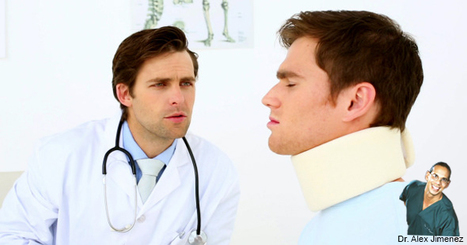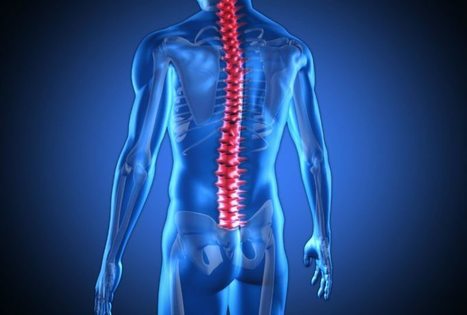 Your new post is loading...
 Your new post is loading...
The hamstring muscles are the large group of muscles found on the posterior side of the thigh, extending from the bottom of the pelvis to the back of the shin bone. This set of tendons are essential towards the body’s functions to extend the hip joints and bend the knee joints. The hamstring is used during multiple sporting activities and everyday activities alike but, when you experience a pulled hamstring muscle, its symptoms can affect the body’s movements. There are different types of hamstring injuries and depending on the severity, symptoms can be categorized into three different grades, each varying from each other.
Whiplash is medically defined as an injury produced when the soft tissue in the spine is stretched and strained after the head jolts abruptly in a quick, back-and-forth movement in any direction. This sudden shift of the head often leads to the damage of the ligaments and tendons in the neck, causing the familiar symptoms associated with this type of injury. A whiplash injury commonly occurs during an automobile accident, although strenuous sports and activities, such as swimming, can also cause injury. The most common symptoms of whiplash are pain and stiffness in the neck that, despite being mild in most cases, can cause limited mobility in the individual or may cause headaches as a result.
The structure of the cervical area of the spine consists of 7 vertebrae, normally aligning into a slight C-shaped curvature referred to as cervical lordosis. The curve of the cervical spine is constructed to support the head and spine, simultaneously balancing the body. But occasionally, the neck will develop an abnormal curve that causes the spine to lose its natural misalignment and could result in further complications. Occasionally, a normal cervical lordosis will develop an abnormal curvature where the neck will exceedingly begin to curve forward, misaligning the spine. The inward cervical curvature can make the head appear insignificantly pushed forward from its normal position.
Cervical radiculopathy is a medical term used to describe a series of symptoms resulting from various conditions on the cervical spine due to dysfunction on one or multiple spinal nerve roots. The majority of the conditions affecting the spine in the neck area result in compression of the nerves which trigger the physical symptoms relating to radiculopathy. There’s numerous types of damage that can cause cervical radiculopathy to develop. The irritation of the spinal nerve roots caused by compression will damage the nerves, leading to pain, tingling and loss of sensation in the hands and arms, as well as muscle weakness. These symptoms are characteristically known when a person has experienced cervical radiculopathy
Arthritis through degeneration, also known as osteoarthritis, results in the breakdown of the bone and cartilage of the spine over time from the natural wear and tear that comes with aging. Arthritis can occur in different areas of the spine causing impairing neck or low back problems but, among the different types of osteoarthritis, facet joint arthritis is among the most common of all the degenerative lumbar spine conditions. The joints are covered with articular cartilage that function jointly with the spinal disc spaces between each vertebra to allow movement and flexibility on the spine. Although, like other joints in the body covered with articular cartilage, the facet joint cartilage will breakdown as a result of degeneration which makes them more prone to be affected by arthritis.
Spondylolisthesis is a condition of the lower back that develops when a single vertebra in the lumbar spine shifts forward over the vertebrae below it, misaligning the natural structure of the spine. The most common cause for this condition is degeneration in the spine. Degeneration begins around the age of 50 and can lead to many issues if left untreated but starting out early with the appropriate exercises will benefit your symptoms associated with spondylolisthesis. Physical therapy is one of the non-surgical ways to treat spondylolisthesis. After completing treatment, following up with a proper routine of stabilization exercises together with flexion and stretching will strengthen the back muscles, restoring back your stability to better support the spine and help you deal with the condition and its symptoms.
El Paso’s chiropractor, Dr. Alex Jimenez discusses the causes of sciatic nerve pain and its symptoms. Sciatica, refers to a group of symptoms instead of a single condition. Sciatic pain most commonly affects the lower back, hip, buttocks, and outer side of the leg. The greater majority of the population has experienced some form of low back pain in their lifetime and the causes for their sciatic nerve pain are numerous. Sciatica is characterized by symptoms of sharp pain extending from the lower back down to the leg, tingling sensations and numbness that is caused by compression, irritation, or pressure of the sciatic nerve.
Cervical spondylosis, also referred to as cervical osteoarthritis, is an age related condition where the cervical spine degenerates as a result of wear and tear on the vertebrae and cartilage. Spinal degeneration changes naturally occur with age, usually beginning in people over the age of 55, but every individual ages differently. The natural aspects of aging affect some people more than others, depending on how much the body is overworked. Weakness of the muscles and tingling can also be associated with cervical spondylosis since the degeneration of the spine makes the spaces in between the vertebrae smaller, causing an impingement of the nerves in the cervical area.
Thoracic outlet syndrome (TOS) is a condition where the brachial plexus nerve bundles and the blood vessels, located in the passage between the anterior and middle scalene down to the brachial plexus pass, become entrapped in this area by tightness of the neck and shoulder muscles, compressing the nerves. The impingement of the nerves in a person suffering from this condition can cause a collection of symptoms from numbness and tingling sensations on the extremities, to weakness and most commonly, pain of various degrees during motion of the neck, shoulders, and upper extremities. Discoloration in the area as a result of diminished circulation is also possible.
The piriformis muscle is the largest and most important of the rotator hip muscles found in the body. Located between the middle of the buttocks and the sacrum, the piriformis muscle functions by rotating the leg and foot outward. A major issue among athletes and the general public is that the sciatic nerve runs under or through the piriformis muscle. Overworking or everyday stress on the body can cause the piriformis muscle to tighten, leading to irritation, swelling, and ultimately pinching of the sciatic nerve, known as piriformis syndrome. Once you have piriformis syndrome, you experience pain in the buttocks that travels down the leg of the affected piriformis muscle.
|
The structure of the neck, or cervical spine, consists of 7 vertebrae, extending from the skull to the upper torso, or the thoracic spine. The bones, ligaments, tendons, and muscles of the neck function together to support and balance the head as well as provide mobility. But, when a condition or injury causes an abnormality or damage to the cervical spine, the well-known symptoms of pain and stiffness can develop. Neck pain is occasionally experienced by many people although some causes for neck pain are more common than others.
Spasmodic torticollis, also known as cervical dystonia, is a medical condition in which the muscles of the neck involuntarily contract and causes the posture of the head to abnormally twist or turn to it’s side or in some cases, tilt forward or backward. Torticollis may also cause muscle spasms or pinched nerves that could result in symptoms of pain and discomfort. The symptoms are known to progress gradually and reach a stage where the condition stabilizes. A person affected by cervical dystonia may experience abnormal head movements towards a single direction or in different directions. Other symptoms include neck pain that radiates from the neck to the shoulders accompanied by severe headaches.
A broken neck, or cervical fracture, is diagnosed when a single or multiple of the seven cervical vertebrae in your neck suffer an injury that results in a fracture, break or crack, in the bone. Trauma to the cervical spine resulting in injury are known to be fairly common, especially among athletes but a broken neck usually leads to further complications and pain. There’s various ways of preventing a fracture to your cervical spine. The neck is a very important structure that supports the head, connecting it to the shoulders and the body as well as protecting the spinal nerve roots that connect from the brain to the rest of the body. Avoiding injury is optimal for everyone as a fractured neck can result in serious complications depending on the degree of the injury.
While low back pain is remarkably common, the issues are caused by a variety of conditions or injuries involving the intricate network of spinal muscles, nerves, bones, discs, or tendons in the lumbar spine. An affliction to any of the local structures of the lumbar spine can result in radiating pain that may travel to other parts of the body but the symptoms and severity of low back pain vary greatly for each individual. These are 5 common conditions that could be the source of your low back pain.
The irritating pain that accompanies tight muscles along with limited mobility and the numbness that extends down your buttocks and legs are the all too familiar symptoms associated with low back pain relating to conditions of the lumbar spine. But, when your lumbar back pain points to the sacroiliac joint instead, what are your treatment options? The function of the sacroiliac joint is to support the movements of the lower extremities. With overuse or underuse, the local muscles surrounding the joint may become inflamed or tight, adding pressure and stress that will often lead to sacroiliac joint dysfunction, the possible true cause for your low back pain.
Your low back pain could be caused by many reasons, characterized by the familiar symptoms of sciatica, but an additional pain, numbness, or tingling in both of your legs could be indicating another common condition associated with low back pain, lumbar spinal stenosis. Lumbar spinal stenosis is a progressive spinal condition identified by degenerative changes in the spine that lead to a narrowing of the spinal canal. Through time, the narrower spinal canal begins to pinch the spinal nerve roots causing the well-known low back pain.
Chiropractic care focuses on re-establishing the natural healing of the body through manual adjustments and manipulation of the spine. A chiropractor diagnoses and treats neuromuscular disorders by restoring a healthy functionality between the spine and the nervous system, together with educating on the proper stretches, exercises, and a balanced nutrition to promote further healing. Chiropractic treatment restores normal spinal mobility which in turn alleviates the irritation of the spinal nerve that causes pain and affects the function of the other systems in the body. A chiropractor will offer relief to many conditions and disorders.
The psoas muscles are a part of the iliopsoas muscle group. This important set of muscles works together with the other muscles of the hip to flex and extend the hip joints and thighs. The psoas muscles also work in conjunction with the spinal muscles to support the lumbar spine. If the psoas is not healthy or strong enough, you will start noticing other problems surge throughout your body. For many athletes, especially runners, the psoas muscles are constantly being overworked with repetitive activity and movements that eventually can lead to stress and tension of the muscles. As a result, the psoas muscles can become tightened and limit the range of movement in the hip sockets also adding strain on the lumbar spine and knees.
Neck pain is one of the most common types of pain experienced by the general public. Many types of conditions and injuries can cause neck pain, such as arthritis in the neck or a whiplash injury from an automobile accident. Neck pain can range from milder degrees of irritation and discomfort to a more severe and debilitating degree, but there are also other symptoms associated with cervical spine pain. Besides neck pain, another common symptom associated with cervical spine pain is a decreased neck range of motion. The neck range of motion is the degree to how much an individual can bend, extend, rotate, and laterally bend their head and neck. People with neck pain also suffer from stiffness, tight muscles in the area, and aching or burning, which is the leading cause for the limited mobility of the neck.
|



 Your new post is loading...
Your new post is loading...


























Warming-up the hamstring muscles before performing a high impact sport is very important. This group of tendons is majorly used during running or jumping but if the muscles are overexerted, a hamstring tear may occur. Hamstring injury doesn't only result from a sport, regular everyday activities where the muscles are stretched beyond their limit can also affect the health of the hamstrings.